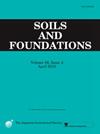Evaluation of the damping ratio of compacted sodium and calcium bentonites in unsaturated conditions
IF 3.3
2区 工程技术
Q2 ENGINEERING, GEOLOGICAL
引用次数: 0
Abstract
Bentonites are going to be part of the Engineered Barrier System (EBS) in deep geological disposal facilities for the safe disposal of spent nuclear fuel. Some of these repositories might be constructed in tectonically active locations, and some other repository locations might have seismic risks in future related to climate changes (e.g. glaciations).
The damping ratio is one of the parameters considered in dynamic analysis, and it can be measured by different methods. In this work, the damping ratio was measured in two different bentonites with the resonant column device and in one of these bentonites, it was also measured with the hollow cylinder, simple shear and triaxial tests in unloading–reloading paths. The results are presented in Pintado et al. (2019; 2023). The tests were carried out at different laboratories.
The samples were compacted at different dry densities and degrees of saturation and tested with different confinement pressures and strain levels to study the influence of the shear strain, degree of saturation, dry density and confinement pressure and also the influence of the test method. The two studied bentonites had different plasticity indices which was also considered in the analysis.
The results showed a clear dependence of the damping ratio on the confinement pressure and the shear strain but not as clear on the degree of saturation, the dry density and the plasticity index. The damping ratio measured by the hollow cylinder test followed the tendency of the resonant column results. The triaxial test presented larger values of damping ratios than following the tendency of the hollow cylinder and resonant column tests. The simple shear test did not follow the tendency of the other tests, presenting lower damping ratio values. All tests presented large scatter.
评估非饱和条件下压实钠基和钙基膨润土的阻尼比
膨润土将成为安全处置乏核燃料的深层地质处置设施中工程屏障系统(EBS)的一部分。其中一些处置库可能建在地质构造活跃的地区,而另一些处置库可能在未来因气候变化(如冰川变化)而面临地震风险。在这项工作中,使用共振柱装置测量了两种不同膨润土的阻尼比,还在其中一种膨润土中使用空心圆柱体、简单剪切和卸载-重载路径下的三轴试验测量了阻尼比。结果见 Pintado 等人(2019 年;2023 年)。测试在不同的实验室进行。样品在不同的干密度和饱和度下压实,并在不同的约束压力和应变水平下进行测试,以研究剪切应变、饱和度、干密度和约束压力的影响,以及测试方法的影响。结果表明,阻尼比与封闭压力和剪切应变有明显的关系,但与饱和度、干密度和塑性指数的关系并不明显。空心圆柱体试验测得的阻尼比与共振柱试验结果的趋势一致。三轴试验得出的阻尼比数值比空心圆柱体和共振柱试验得出的数值大。简单剪切试验没有遵循其他试验的趋势,阻尼比值较低。所有试验都呈现出较大的分散性。
本文章由计算机程序翻译,如有差异,请以英文原文为准。
求助全文
约1分钟内获得全文
求助全文
来源期刊

Soils and Foundations
工程技术-地球科学综合
CiteScore
6.40
自引率
8.10%
发文量
99
审稿时长
5 months
期刊介绍:
Soils and Foundations is one of the leading journals in the field of soil mechanics and geotechnical engineering. It is the official journal of the Japanese Geotechnical Society (JGS)., The journal publishes a variety of original research paper, technical reports, technical notes, as well as the state-of-the-art reports upon invitation by the Editor, in the fields of soil and rock mechanics, geotechnical engineering, and environmental geotechnics. Since the publication of Volume 1, No.1 issue in June 1960, Soils and Foundations will celebrate the 60th anniversary in the year of 2020.
Soils and Foundations welcomes theoretical as well as practical work associated with the aforementioned field(s). Case studies that describe the original and interdisciplinary work applicable to geotechnical engineering are particularly encouraged. Discussions to each of the published articles are also welcomed in order to provide an avenue in which opinions of peers may be fed back or exchanged. In providing latest expertise on a specific topic, one issue out of six per year on average was allocated to include selected papers from the International Symposia which were held in Japan as well as overseas.
 求助内容:
求助内容: 应助结果提醒方式:
应助结果提醒方式:


